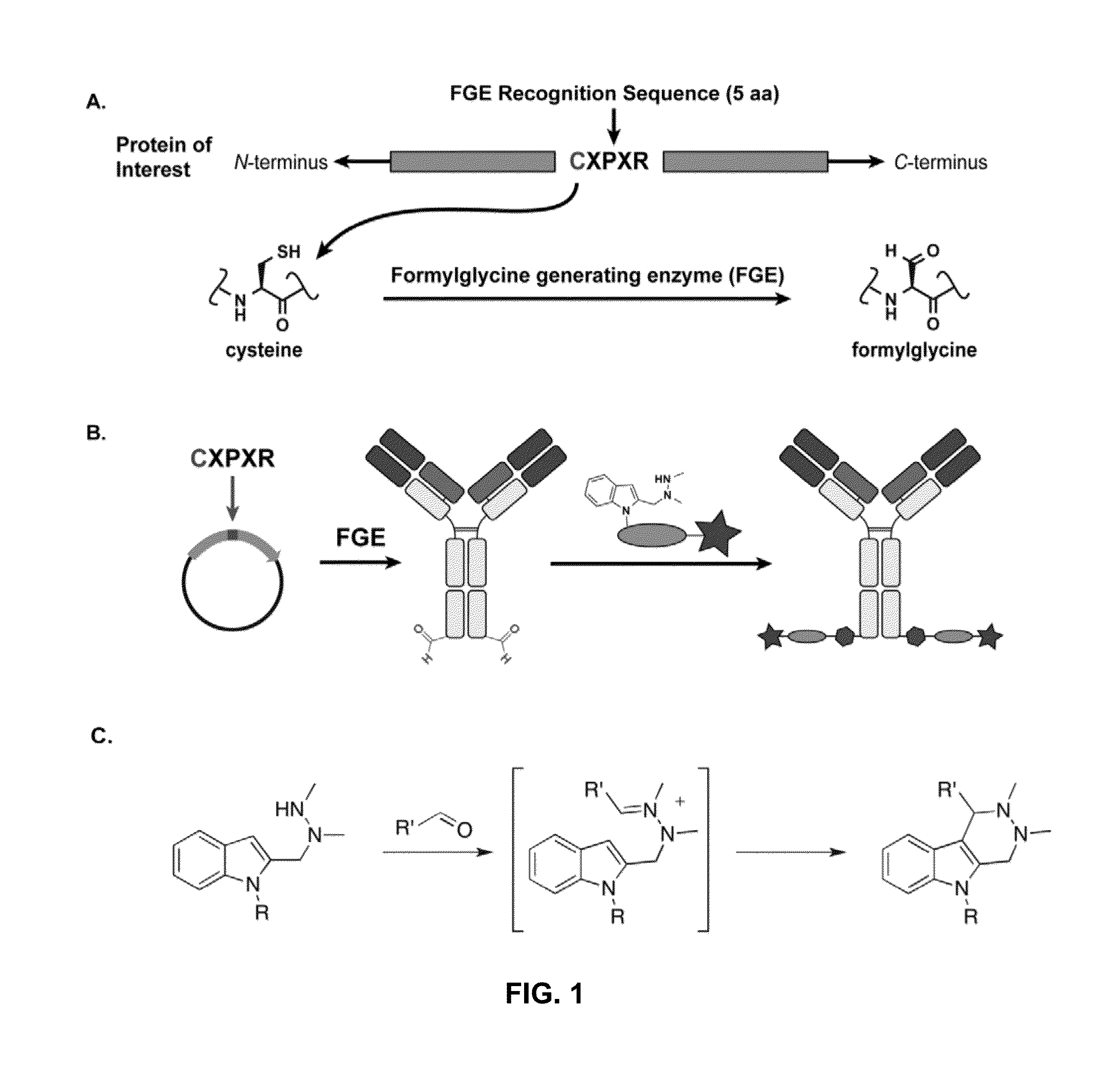Anti-Her2 Antibody-Maytansine Conjugates and Methods of Use Thereof
a technology of antibody-maytansine and conjugates, which is applied in the field of protein-small molecule therapeutic conjugates, can solve the problems of homogeneous mixture of conjugates, production of biologically active proteins, and homogeneous form
- Summary
- Abstract
- Description
- Claims
- Application Information
AI Technical Summary
Benefits of technology
Problems solved by technology
Method used
Image
Examples
example 1
[0531]Experiments were performed to create site-specifically conjugated antibody-drug conjugates (ADCs). Site-specific ADC production included the incorporation of formylglycine (FGly), a non-natural amino acid, into the protein sequence. To install FGly (FIG. 1), a short consensus sequence, CXPXR, where X is serine, threonine, alanine, or glycine, was inserted at the desired location in the conserved regions of antibody heavy or light chains using standard molecular biology cloning techniques. This “tagged” construct was produced recombinantly in cells that coexpress the formylglycine-generating enzyme (FGE), which cotranslationally converted the cysteine within the tag into an FGly residue, generating an aldehyde functional group (also referred to herein as an aldehyde tag). The aldehyde functional group served as a chemical handle for bioorthogonal conjugation. A Hydrazino-iso-Pictet-Spengler (HIPS) ligation was used to connect the payload (e.g., a drug, such as a cytotoxin) to F...
example 2
[0583]Anti-HER2 ADCs that varied at the linker portion were produced. The ADCs were made using aldehyde-tagged anti-HER2 proteins conjugated using the Hydrazinyl-iso-Pictet-Spengler (HIPS) ligation to a maytansine payload. The resulting ADCs were homogenous, with well-defined drug-to-antibody ratios (DARs) as assessed by hydrophobic interaction chromatography (HIC). Differences in linker design affected the efficacy of these conjugates in both single and multidose efficacy xenograft studies.
[0584]An aldehyde tag was used for site-specifically functionalizing proteins for chemical modification. The genetically-encoded tag included a pentapeptide sequence (CXPXR) that was specifically recognized by formylglycine-generating enzyme (FGE). During protein expression in cells, the cysteine residue in the sequence was recognized by FGE and oxidized cotranslationally to formylglycine. The resulting aldehyde was used as a bioorthogonal chemical handle for ligation. Linkers terminating in a 2(...
example 3
[0673]A linker containing a piperidin-4-amino (4AP) group was synthesized according to Scheme 25, shown below.
Synthesis of (9H-fluoren-9-yl)methyl 4-oxopiperidine-1-carboxylate (200)
[0674]To a 100 mL round-bottom flask containing a magnetic stir bar was added piperidin-4-one hydrochloride monohydrate (1.53 g, 10 mmol), Fmoc chloride (2.58 g, 10 mmol), sodium carbonate (3.18 g, 30 mmol), dioxane (20 mL), and water (2 mL). The reaction mixture was stirred at room temperature for 1 h. The mixture was diluted with EtOAc (100 mL) and extracted with water (1×100 mL). The organic layer was dried over Na2SO4, filtered, and concentrated under reduced pressure. The resulting material was dried in vacuo to yield compound 200 as a white solid (3.05 g, 95% yield).
[0675]1H NMR (CDCl3) δ 7.78 (d, 2H, J=7.6), 7.59 (d, 2H, J=7.2), 7.43 (t, 2H, J=7.2), 7.37 (t, 2H, J=7.2), 4.60 (d, 2H, J=6.0), 4.28 (t, 2H, J=6.0), 3.72 (br, 2H), 3.63 (br, 2H), 2.39 (br, 2H), 2.28 (br, 2H).
[0676]MS (ESI) m / z: [M+H]+ C...
PUM
| Property | Measurement | Unit |
|---|---|---|
| Light | aaaaa | aaaaa |
Abstract
Description
Claims
Application Information
 Login to View More
Login to View More - R&D
- Intellectual Property
- Life Sciences
- Materials
- Tech Scout
- Unparalleled Data Quality
- Higher Quality Content
- 60% Fewer Hallucinations
Browse by: Latest US Patents, China's latest patents, Technical Efficacy Thesaurus, Application Domain, Technology Topic, Popular Technical Reports.
© 2025 PatSnap. All rights reserved.Legal|Privacy policy|Modern Slavery Act Transparency Statement|Sitemap|About US| Contact US: help@patsnap.com



